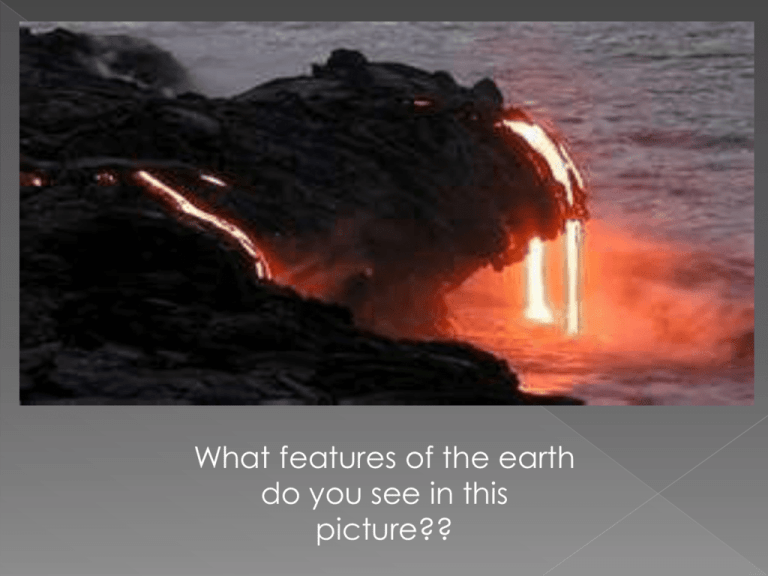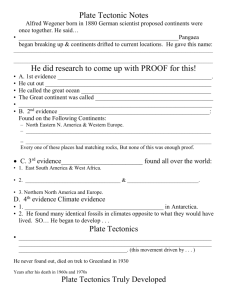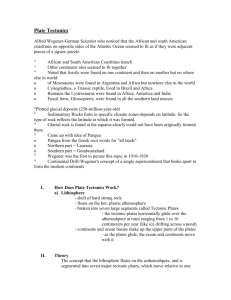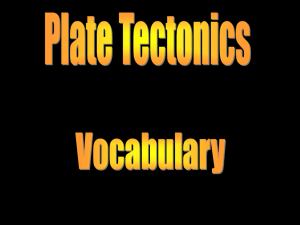plate
advertisement

What features of the earth do you see in this picture?? What is the burning rock called? Where does it come from? What causes such an eruption of lava from the earth?? From this image showing lava flowing from dry land into the ocean, what do you think this chapter might be about?? Objectives: › Describe how the continents moved over the past 250 million years › Explain the evidence supporting continental drift › Make a model of the supercontinent Pangaea A puzzling World › Look at the map on the next slide and study the shapes of the continents closely. › What do you notice about the shapes of the continents on the opposite sides of the Atlantic Ocean? Hundreds of years ago, the 1st _________ ________ were made People noticed that some of the continents could ___________ like ________ _________ But if the continents were once joined, how could they have moved?? During the 1800’s, scientists studying ______ ____ ______ found evidence that seemed to support the idea of ________ ____________ What evidence do you think this was? German _____________ Gathered evidence and proposed the ___ ______ ___ _________ __________ Claimed that all landmasses were once joined as a supercontinent – _____________ Theory not accepted until the 1950’s Pangaea Worksheet Page 20 of Integrated Resource Book Scientists have collected large amounts of _______ on how the continents _______ They have pieced together a ________ of the continents ______ ________ ____ ___________________ All of the continents were part of one ___________________ called Pangaea Step 1 ______ ________years ago (Mesozoic Era) Pangaea began to _______ ___________ across its __________ 2 major continents formed › __________________ (south) › __________________ (north) Step 2 _____ _________ years ago _________________ began to break up into _________ pieces that would become › _______________ › _______________ › _______________ › _______________ › _______________ Step 3 ____ _________ years ago _________ breaks apart forming landmasses that would become › ________________ › ________________ › ________________ _________, which has been drifting north for 100 million years, collides with ________ Step 4 Continents as they _________ _______ Do you think the continents will keep moving around?? Watch movie “Plate Tectonics – Our Restless Planet” from Discovery Education Write down 10 things you learned from movie and hand in at end of class Continental Drift Lab Page 29 of Laboratory Manual Scientists have collected a lot of evidence supporting 2 related conclusions › 1.____________________ _____________________ _____________________ _____________________ › 2. _____________________ _____________________ _____________________ _____________________ A _________ kind of organism or species appears on earth only in ______ _______and then _________ _____ Animals that swim and plants with windblown seeds can spread _________ ___ _________ But, _______ _________ can only spread out across land ___________________ found fossils of an ancient fernlike plant called _____________ in › _________________ › _________________ › _________________ › _________________ › _________________ What can they infer from this?? That all of these continents were ________________ at one time!! Fossils of several other species have a similar pattern None of these organisms could have __________ ___ _____________ How could they end up on different continents?? Fossils of _____________, a Triassic land reptile, were found in Africa, Antarctica, and India Fossils of _____________, a freshwater reptile, were found in Africa and South America Fossils of _____________, a Triassic land reptile, were found in South America and Africa Fossil evidence also shows that the continents have ___________ over the earth’s surface Fossils found in _____________ show it once was home to vast ______ _________ and _________ full of plant and animal life How could this be?? There are many ___________ between the rocks and landforms of _______ and ______ _________ If the 2 continents are fitted together, their __________ _______ ______ ____ Also, the mountain’s rocks are similar in _____ _____ _______ Were the 2 mountain ranges once one?? Watch movie “Fossils – Windows into the Past” from Discovery education” Write down 10 fossil facts from movie and hand in at the end of class. Is it True?? › Recall a time when someone told you that something you believed to be true, really wasn’t. › How did you react? › Was your reaction similar to the way scientists reacted to Wegener’s ideas? ______ are huge masses of ______ that move ________ over land During the ice ages, glaciers spread _________ _____ _____ _________ Glaciers always move __________ _____________ Rocks that show evidence of glaciers at the end of the _________ ______ were found in › › › › _________________ _________________ _________________ _________________ How could this be if it is usually hot in these places?? Rocks can also show the ________________ in which glaciers ________________ Ice age glaciers seemed to travel __________ from present day ________ This doesn’t make sense!! Can only be explained if the following continents were once part of the _______ _________ › _________________ › _________________ › _________________ › _________________ › _________________ 1. Which present day continents were once part of Gondwanaland? 2. List 2 types of evidence that support the idea of continental drift. 3. What will happen to the size of the Atlantic Ocean in the next 50 million years? 4. If you found evidence of glaciers in areas with warm climates, what would you conclude? 5. How does evidence of glacier movement support the idea of a single landmass? Objectives: › Describe the process of sea-floor spreading › Identify different types of plate boundaries › Explain what happens when plates come together › Infer from observation of a large surface feature what kind of plate boundary produced it Moving Plates › The word plate means “a smooth, flat, thin piece of material” › The word tectonic means “having a strong and widespread impact” › Does this give you enough information to get a good idea of what plate tectonics is all about? 1950’s – Scientists finally got the tool they needed to study the ocean floor _______ __________ – could bounce ________ waves off the ocean bottom › if a sound wave bounced back _________, the ocean floor was ___________ › if a sound wave took longer to bounce back, the ocean floor was __________ This allowed them to make a map of the ______________ of the ocean floor Scientists discovered long, underwater ____________________ The ranges formed one long __________ snaking through all of the oceans (baseball seams) This ________________ had a deep valley running the length of its crest Scientists found rocks from the ocean bottom were _________ than the rocks in the ____________ Also the rocks _________ to the mid-ocean ridge were the ______________ Why do you think this is?? 1960 – American geologist ______________ proposed the __________ ________________________ › 1. Mid-ocean ridge is a huge ___________ in the earth’s crust where the hot _________ pushes up › 2. The pieces of crust on either side of the crack are slowly moving _______ from each other › 3. As they move, _______ _______ from the mantle wells up between them, forming ______ _________ ___________ New ocean crust is constantly being _______ during sea-floor spreading. So why doesn’t the earth keep growing bigger?? Because at the same time, ________ ocean crust is being _________ ____ in deep _______ ___________! The ______ _________ of oceanic crust stays the _______ and it is totally remade every ______ __________years or so. Other scientists sampled rocks on ______ _______of the mid-ocean ridge They found a pattern of _________ ________ _________ that was _________ on each side The stripes were formed when the earth’s magnetic field caused ___________ to line up in the rocks The stripes were different because earth’s magnetic field ___________ itself many times in the past Shows that new ocean crust is added to ______ ________ of the mid-ocean ridge at the _________ _________ Watch movie “The Endless Voyage – Making the Pieces Fit” from Discovery Education Write down 10 new facts that you learned and hand in at end of class Magnetic Patterns on the Ocean Floor Page 98 in Textbook Earth’s lithosphere is divided into pieces called __________ The plates are _______ ___________, each at a different rate and direction A lithospheric plate moves as a _______, floating on top of the ______________ (like a flat rock on wet cement) Each lithospheric plate is made up of both ______ ____ ___________ ________ ________ is dense and made up of ______ _____ ___________ _________ _______ is less dense and made up of _______ _____ ___________ 6 of the earth’s 7 major plates are ______________ plates They carry mostly continental crust material They consist of _____ continent and a large section of __________ ________ One major plate and several smaller plates are oceanic plates They are made up entirely of ___________ __________ If plates are moving, what kinds of interactions are possible?? Demonstration with 2 students Plates moving ________ from each other Places where ________ _______ __ ____ _______ ______ _____ ______are divergent boundaries Can also occur in continents and signal the beginning of the continent’s ___________ Two plates _______ ________ ___ ________ Usually one plate moves _________ another and crust material is _________ Produce many different kinds of features on earth’s surface Two plates ______ ____ ________ ___________ beside each other Crust material is ______ created or destroyed The break or crack along which movement occurs is called a _____________ ____________ Watch first part of movie “Endless Voyage – World in Motion” from Discovery Education Define the following and hand in at end of class: Divergent Boundary Convergent Boundary Transform Boundary __________ of 2 plates release huge amounts of _________ Energy causes important _________ __________ – volcanic activity or mountain building What happens depends on the ______ ___ _______that meet or converge The more dense plate is pushed down under the other – ______________ Lower plate goes into _____________, melts, and is absorbed into ___________ Causes ______ ________to rise up through other plate › Volcanoes form on ocean bottom and build a chain or _______ ___ ____________ › It also creates a ________ _________ ______ – deepest parts of the ocean ____________ plate is always _________ so it will be pushed down under the ____________ Oceanic plate melts into ________________, causing molten rock to rise up through ______________ plate ___________ __________ forms, usually containing ___________ Both plates are the same __________ and _____________ Neither can move ___________ the other They __________ and _________ each other, forming _____ ________ Plates become joined as a _______ _________ Certain instruments measure the slow movements of earth’s plates, so the _______ and ______________ of most have been determined – can _______ future movement The movement and location of plates explains many of earth’s features: › › › › › › _______________________ _______________________ _______________________ _______________________ _______________________ _______________________ ___________________ One of the few transform boundaries on land Its movement causes severe _______________ (California) ________ ___________ Nazca plate ____________ under the South American plate caused this mountain range ______ _____ _____ New ____________ boundary beginning to split Africa in two _________________ __________ mountains on earth Resulted from ____________ of two continental plates _________________ Ocean trench more than _______ _________________ Created by _____________ of Pacific plate under the Philippine plate _____ ______ ________ _____________(VLBI) Uses ________ signals from distant _______ (stars) to measure plate movement Two stations far apart on earth receive signals from the same quasar Get a precise measurement of _________ between the 2 stations Make same measurement at a later date – find out how fast the earth’s plates are ______________ Hawaii and Japan are moving closer to each other at a rate of __________________________ The North American and Eurasian plates are moving apart at a rate of ______________________ 1. What happens during sea-floor spreading? 2. Describe 3 types of plate boundaries, and give an example of each. 3. Explain how mid-ocean ridges and subduction zones are similar. How are they different? 4. Japan is made up of a long chain of islands formed from volcanoes. What kind of plate boundary do you think is nearby? 5. What happens at a continentalcontinental plate boundary? Objectives: › Describe two models of how convection occurs in the earth’s mantle. › Explain how a tectonic plate may move as part of a convection cell. › Evaluate models explaining plate movement by convection. › Compare and contrast two models for how convection results in the movement of plates Convey the Concept › Describe how a conveyor belt works. › Make a list of where conveyor belts are used. › What happens to objects on a conveyor belt? Scientists know: › ___________________ ___________________ › ___________________ ___________________ › ___________________ ___________________ Still don’t know for sure what the driving force of plate movement is! Driving force for plate movement has something to do with __________________ __________________ _____________ cells occur in the mantle, which are circular units of movement But how exactly does convection occur?? Two Models for Convection First Model - Passive Plates are _______________ _________ with the movement of convection Plates are like ___________ on a giant conveyor belt ________ _____________ form where convection pushes material up _______ ______________ form where convection goes back down into the mantle Second Model - Active Plates themselves have an _______ ______ in convection A plate is ________ and ______ _______ than the asthenosphere It will sink into a _________ ________and pull the rest of the plate down This helps _________ the circular movement of convection 1. What are two models for convection in the mantle? 2. If convection cells in the mantle are like conveyor belts, what are plates like? 3. Which model do you think best explains how convection moves the plates? Explain the reason for your choice. 4. What are the similarities and differences between the two major models explaining how convection causes plate movement?









